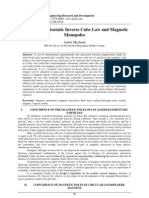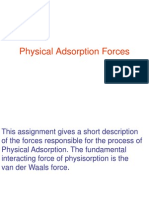0 ratings0% found this document useful (0 votes)
Quantum Mechanical Treatment & Exchange Interactions: M.Phil. Physics
Quantum Mechanical Treatment & Exchange Interactions: M.Phil. Physics
Uploaded by
abdul mananThe document discusses the quantum mechanical exchange interaction, which occurs between identical particles. It affects the expectation value of distance between particles. For fermions like electrons, the exchange interaction increases the distance due to Pauli repulsion, while for bosons it decreases the distance and can cause condensation. It arises due to the antisymmetric or symmetric nature of particle wavefunctions upon exchange. The exchange interaction is responsible for phenomena like ferromagnetism but is not a true force.
Copyright:
© All Rights Reserved
Available Formats
Download as PPTX, PDF, TXT or read online from Scribd
Download as pptx, pdf, or txt
Quantum Mechanical Treatment & Exchange Interactions: M.Phil. Physics
Quantum Mechanical Treatment & Exchange Interactions: M.Phil. Physics
Uploaded by
abdul manan0 ratings0% found this document useful (0 votes)
The document discusses the quantum mechanical exchange interaction, which occurs between identical particles. It affects the expectation value of distance between particles. For fermions like electrons, the exchange interaction increases the distance due to Pauli repulsion, while for bosons it decreases the distance and can cause condensation. It arises due to the antisymmetric or symmetric nature of particle wavefunctions upon exchange. The exchange interaction is responsible for phenomena like ferromagnetism but is not a true force.
Original Description:
magnetic materilas
Original Title
Exchange Interaction
Copyright
© © All Rights Reserved
Available Formats
PPTX, PDF, TXT or read online from Scribd
Share this document
Did you find this document useful?
Is this content inappropriate?
The document discusses the quantum mechanical exchange interaction, which occurs between identical particles. It affects the expectation value of distance between particles. For fermions like electrons, the exchange interaction increases the distance due to Pauli repulsion, while for bosons it decreases the distance and can cause condensation. It arises due to the antisymmetric or symmetric nature of particle wavefunctions upon exchange. The exchange interaction is responsible for phenomena like ferromagnetism but is not a true force.
Copyright:
© All Rights Reserved
Available Formats
Download as PPTX, PDF, TXT or read online from Scribd
Download as pptx, pdf, or txt
0 ratings0% found this document useful (0 votes)
Quantum Mechanical Treatment & Exchange Interactions: M.Phil. Physics
Quantum Mechanical Treatment & Exchange Interactions: M.Phil. Physics
Uploaded by
abdul mananThe document discusses the quantum mechanical exchange interaction, which occurs between identical particles. It affects the expectation value of distance between particles. For fermions like electrons, the exchange interaction increases the distance due to Pauli repulsion, while for bosons it decreases the distance and can cause condensation. It arises due to the antisymmetric or symmetric nature of particle wavefunctions upon exchange. The exchange interaction is responsible for phenomena like ferromagnetism but is not a true force.
Copyright:
© All Rights Reserved
Available Formats
Download as PPTX, PDF, TXT or read online from Scribd
Download as pptx, pdf, or txt
You are on page 1/ 11
Quantum Mechanical
Treatment & Exchange
Interactions
M.Phil. Physics
EXCHANGE
INTERACTION
• The exchange interaction (with an
exchange energy and exchange term) is a
quantum mechanical effect that only occurs
between identical particles.
• The effect is due to the wave function of
indistinguishable particles being subject to
exchange symmetry,
• That is, either remaining unchanged (symmetric) or
changing sign (Antisymmetric) when two particles
are exchanged.
Both bosons and fermions can experience the
exchange interaction.
• For fermions, this interaction is sometimes called Pauli
repulsion and is related to the Pauli exclusion principle.
• For bosons, the exchange interaction takes the form of an
effective attraction that causes identical particles to be found
closer together, as in Bose–Einstein condensation.
• The exchange interaction alters the expectation value of the
distance when the wave functions of two or more
indistinguishable particles overlap.
• This interaction increases (for fermions) or decreases (for
bosons) the expectation value of the distance between
identical particles (compared to distinguishable
particles).
• Among other consequences, the exchange interaction is
responsible for ferromagnetism .
• Exchange interaction effects were discovered
independently by physicists Werner heisenberg and
Paul Dirac in 1926.
• The exchange interaction is sometimes called the exchange
force. However, it is not a true force and should not be
confused with the exchange forces
produced by the exchange of force carriers, such as the
electromagnetic force produced between two electrons by
the exchange of a photon, or the strong force between two
quarks produced by the exchange of a gluon.
• QUANTUM MECHANICAL PARTICLES ARE CLASSIFIED AS BOSONS OR FERMIONS. THE
SPIN– STATISTICS THEOREM OF QUANTUM FIELD THEORY DEMANDS THAT ALL
PARTICLES
WITH HALF-INTEGER SPIN BEHAVE AS FERMIONS AND ALL PARTICLES WITH INTEGER
SPIN BEHAVE AS BOSONS.
• MULTIPLE BOSONS MAY OCCUPY THE SAME QUANTUM STATE; HOWEVER, BY THE
PAULI EXCLUSION PRINCIPLE, NO TWO FERMIONS CAN OCCUPY THE SAME STATE.
• SINCE ELECTRONS HAVE SPIN 1/2, THEY ARE FERMIONS. THIS MEANS THAT THE
OVERALL WAVE FUNCTION OF A SYSTEM MUST BE ANTISYMMETRIC WHEN TWO
ELECTRONS ARE EXCHANGED, I.E. INTERCHANGED WITH RESPECT TO BOTH
SPATIAL AND SPIN COORDINATES. FIRST, HOWEVER, EXCHANGE WILL BE EXPLAINED
WITH THE NEGLECT OF SPIN.
EXCHANGE OF SPATIAL
COORDINATES
• TAKING A HYDROGEN MOLECULE-LIKE SYSTEM (I.E. ONE WITH TWO
ELECTRONS), ONE MAY ATTEMPT TO MODEL THE STATE OF EACH ELECTRON
BY FIRST ASSUMING THE ELECTRONS BEHAVE INDEPENDENTLY, AND TAKING
WAVE FUNCTIONS IN POSITION SPACE.
• HAMILTONIAN BETWEEN TWO ELECTRONS IN ORBITALS ΦA AND ΦB CAN BE
WRITTEN IN TERMS OF THEIR SPIN MOMENTA S(A) AND S(B) .THIS IS NAMED
THE HEISENBERG EXCHANGE HAMILTONIAN OR THE HEISENBERG–DIRAC
HAMILTONIAN IN THE OLDER LITERATURE:
• JAB IS TERMED THE EXCHANGE CONSTANT.
You might also like
- The WTF A Level Package Physics Cheat SheetNo ratings yetThe WTF A Level Package Physics Cheat Sheet7 pages
- International Journal of Engineering Research and Development (IJERD)No ratings yetInternational Journal of Engineering Research and Development (IJERD)17 pages
- PHYSICS-2 Theoretical Questions For Final 2014No ratings yetPHYSICS-2 Theoretical Questions For Final 201459 pages
- Induction of Electrostatic Repulsion by Strong GravityNo ratings yetInduction of Electrostatic Repulsion by Strong Gravity10 pages
- 11.2 - Introduction To Particle Physics - Physics LibreTexts PDFNo ratings yet11.2 - Introduction To Particle Physics - Physics LibreTexts PDF4 pages
- The Bridge Between Classical and Quantum MechanicsNo ratings yetThe Bridge Between Classical and Quantum Mechanics9 pages
- FQXi 2017 - 2018 Vladimir Fedorov What Is "Fundamental"No ratings yetFQXi 2017 - 2018 Vladimir Fedorov What Is "Fundamental"12 pages
- EE8409 Electromagnetic Theory: Dr. Shazzat HossainNo ratings yetEE8409 Electromagnetic Theory: Dr. Shazzat Hossain32 pages
- OCR A Physics A-Level: Topic 6.4: Nuclear and Particle PhysicsNo ratings yetOCR A Physics A-Level: Topic 6.4: Nuclear and Particle Physics16 pages
- Aether and The Electric Sea General ScienceNo ratings yetAether and The Electric Sea General Science7 pages
- Classicalmechanicsvsquantummechanics 171210195534No ratings yetClassicalmechanicsvsquantummechanics 17121019553415 pages
- A UNITARY THEORI OF NUCLEAR, ELECTROMAGNETIC AND GRAVITAIONAL FIELDSFrom EverandA UNITARY THEORI OF NUCLEAR, ELECTROMAGNETIC AND GRAVITAIONAL FIELDSNo ratings yet
- Jablonski Diagram - Chemistry LibreTextsNo ratings yetJablonski Diagram - Chemistry LibreTexts4 pages
- CBSE Class 11 NCERT Book Chemistry Part 1 STATES of MATTER Chapter 5No ratings yetCBSE Class 11 NCERT Book Chemistry Part 1 STATES of MATTER Chapter 524 pages
- Aetherometric Theory of Synchronicity - Encyclopedia NomadicaNo ratings yetAetherometric Theory of Synchronicity - Encyclopedia Nomadica2 pages
- What is Charge? – The Redefinition of Atom - Energy to Matter ConversionFrom EverandWhat is Charge? – The Redefinition of Atom - Energy to Matter ConversionNo ratings yet
- Power Knot Measuring Enthalpy To Calculate EfficiencyNo ratings yetPower Knot Measuring Enthalpy To Calculate Efficiency7 pages
- 1) Centre of Gravity, Centre of Mass & CentroidNo ratings yet1) Centre of Gravity, Centre of Mass & Centroid5 pages
- (Ebook) Classical Optics and its Applications by Masud Mansuripur ISBN 9780521881692, 0521881692 All Chapters Instant Download100% (3)(Ebook) Classical Optics and its Applications by Masud Mansuripur ISBN 9780521881692, 0521881692 All Chapters Instant Download86 pages
- Energy Skate Park Basics Phet Activity Review: (Fill in The Blanks)No ratings yetEnergy Skate Park Basics Phet Activity Review: (Fill in The Blanks)2 pages
- Arihant 20 Years Chapterwise Topicwise JEE Main Solved Papers Mathematics-190% (10)Arihant 20 Years Chapterwise Topicwise JEE Main Solved Papers Mathematics-1481 pages
- States of Matter: Paper 1: Practice TestNo ratings yetStates of Matter: Paper 1: Practice Test4 pages
- Quantification of The Local Mechanical Behavior in Dissimilar Metal Welds Using Digital Image Correlation Instrumented Cross-Weld Tensile TestingNo ratings yetQuantification of The Local Mechanical Behavior in Dissimilar Metal Welds Using Digital Image Correlation Instrumented Cross-Weld Tensile Testing16 pages
- Kinematics and Dynamics of Machinery Lab ManualNo ratings yetKinematics and Dynamics of Machinery Lab Manual63 pages
- SC 1.5 Mechanical NDT, Issue 2, 30 April 2020edNo ratings yetSC 1.5 Mechanical NDT, Issue 2, 30 April 2020ed27 pages
- Tutorial 3 - Flow Measurement - Intro To Rotating Equipm - SolutionsNo ratings yetTutorial 3 - Flow Measurement - Intro To Rotating Equipm - Solutions8 pages
- Delhi Public School Surat Revision Worksheet-2 Subject: Physics Class: X Maximum Marks: 20No ratings yetDelhi Public School Surat Revision Worksheet-2 Subject: Physics Class: X Maximum Marks: 204 pages
- CENG 6101 - Lesson 2c - Scheduling PERTNo ratings yetCENG 6101 - Lesson 2c - Scheduling PERT38 pages
- Combined Forced and Natural Convection Heat Transfer in A Deep Lid-Driven Cavity FlowNo ratings yetCombined Forced and Natural Convection Heat Transfer in A Deep Lid-Driven Cavity Flow8 pages
- International Journal of Engineering Research and Development (IJERD)International Journal of Engineering Research and Development (IJERD)
- Induction of Electrostatic Repulsion by Strong GravityInduction of Electrostatic Repulsion by Strong Gravity
- 11.2 - Introduction To Particle Physics - Physics LibreTexts PDF11.2 - Introduction To Particle Physics - Physics LibreTexts PDF
- The Bridge Between Classical and Quantum MechanicsThe Bridge Between Classical and Quantum Mechanics
- FQXi 2017 - 2018 Vladimir Fedorov What Is "Fundamental"FQXi 2017 - 2018 Vladimir Fedorov What Is "Fundamental"
- EE8409 Electromagnetic Theory: Dr. Shazzat HossainEE8409 Electromagnetic Theory: Dr. Shazzat Hossain
- OCR A Physics A-Level: Topic 6.4: Nuclear and Particle PhysicsOCR A Physics A-Level: Topic 6.4: Nuclear and Particle Physics
- A UNITARY THEORI OF NUCLEAR, ELECTROMAGNETIC AND GRAVITAIONAL FIELDSFrom EverandA UNITARY THEORI OF NUCLEAR, ELECTROMAGNETIC AND GRAVITAIONAL FIELDS
- CBSE Class 11 NCERT Book Chemistry Part 1 STATES of MATTER Chapter 5CBSE Class 11 NCERT Book Chemistry Part 1 STATES of MATTER Chapter 5
- Aetherometric Theory of Synchronicity - Encyclopedia NomadicaAetherometric Theory of Synchronicity - Encyclopedia Nomadica
- What is Charge? – The Redefinition of Atom - Energy to Matter ConversionFrom EverandWhat is Charge? – The Redefinition of Atom - Energy to Matter Conversion
- Power Knot Measuring Enthalpy To Calculate EfficiencyPower Knot Measuring Enthalpy To Calculate Efficiency
- (Ebook) Classical Optics and its Applications by Masud Mansuripur ISBN 9780521881692, 0521881692 All Chapters Instant Download(Ebook) Classical Optics and its Applications by Masud Mansuripur ISBN 9780521881692, 0521881692 All Chapters Instant Download
- Energy Skate Park Basics Phet Activity Review: (Fill in The Blanks)Energy Skate Park Basics Phet Activity Review: (Fill in The Blanks)
- Arihant 20 Years Chapterwise Topicwise JEE Main Solved Papers Mathematics-1Arihant 20 Years Chapterwise Topicwise JEE Main Solved Papers Mathematics-1
- Quantification of The Local Mechanical Behavior in Dissimilar Metal Welds Using Digital Image Correlation Instrumented Cross-Weld Tensile TestingQuantification of The Local Mechanical Behavior in Dissimilar Metal Welds Using Digital Image Correlation Instrumented Cross-Weld Tensile Testing
- Tutorial 3 - Flow Measurement - Intro To Rotating Equipm - SolutionsTutorial 3 - Flow Measurement - Intro To Rotating Equipm - Solutions
- Delhi Public School Surat Revision Worksheet-2 Subject: Physics Class: X Maximum Marks: 20Delhi Public School Surat Revision Worksheet-2 Subject: Physics Class: X Maximum Marks: 20
- Combined Forced and Natural Convection Heat Transfer in A Deep Lid-Driven Cavity FlowCombined Forced and Natural Convection Heat Transfer in A Deep Lid-Driven Cavity Flow

























































































